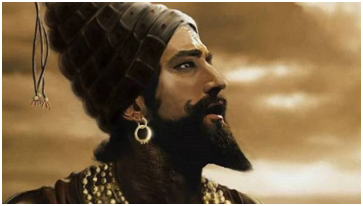Indian History
Chhatrapati Shivaji Maharaj
- 07 Jun 2021
- 7 min read
Why in News
On the occasion of the anniversary of Maratha king’s coronation day (6th June), the Goa government has released a short film on Chhatrapati Shivaji.
Key Points
- Birth:
- He was born on 19th February, 1630 at Shivneri Fort in District Pune in the present-day state of Maharashtra.
- He was born to Shahaji Bhonsle, a Maratha general who held the jagirs of Pune and Supe under the Bijapur Sultanate and Jijabai, a pious woman whose religious qualities had a profound influence on him.
- Early Life:
- He displayed his military zeal for the first time in 1645 when as a teenager, he successfully got control of the Torna Fort which was under Bijapur.
- He also acquired the Kondana Fort. Both these forts were under Adil Shah of Bijapur.
- Important Battle:
| Battle of Pratapgad, 1659 |
|
| Battle of Pavan Khind, 1660 |
|
| Sacking of Surat, 1664 |
|
| Battle of Purandar, 1665 |
|
| Battle of Sinhagad, 1670 |
|
| Battle of Kalyan, 1682-83 |
|
| Battle of Sangamner, 1679 |
|
- Conflict with Mughals:
- He raided Mughal territory near Ahmednagar and in Junnar, 1657.
- Aurangzeb responded to the raids by sending Nasiri Khan, who defeated the forces of Shivaji at Ahmednagar.
- Shivaji defeated a large force of Shaista Khan (Aurangzeb’s maternal uncle) and the Bijapur army in Pune,1659.
- In 1664, the wealthy Mughal trading port of Surat was sacked by Shivaji.
- In June 1665, the Treaty of Purandar was signed between Shivaji and Raja Jai Singh I (representing Aurangzeb).
- As per this treaty, many forts were relinquished to the Mughals and it was agreed that Shivaji would meet Aurangzeb at Agra. Shivaji also agreed to send his son Sambhaji as well.
- Arrest of Shivaji:
- When Shivaji went to meet the Mughal emperor at Agra in 1666, the Maratha warrior felt he was insulted by Aurangzeb and stormed out of the court.
- He was arrested and kept prisoner. The clever escape of Shivaji and his son from imprisonment in disguise out of Agra is legendary today.
- After that there was peace between the Marathas and the Mughals until 1670.
- The jagir of Berar which was granted to Sambhaji by the Mughals was taken back from him.
- Shivaji in response attacked and recovered many territories from the Mughals in a short span of four months.
- Through his military tactics, Shivaji acquired a large part of the land in the Deccan and western India.
- Granted Title:
- He was crowned as the king of the Marathas on 6th June , 1674, at Raigad.
- He took on the titles of Chhatrapati, Shakakarta, Kshatriya Kulavantas and Haindava Dharmodhhaarak.
- The Maratha Kingdom founded by Shivaji grew larger over time and became the dominant Indian power in the early 18th century.
- Death:
- He died on 3rd April 1680.
Administration under Shivaji
- Central Administration:
- It was founded by Shivaji for the sound system of administration which was greatly inspired from the Deccan style of administration.
- Most of the administrative reforms were inspired from Malik Amber reforms in Ahmednagar.
- The King was the supreme head of state who was assisted by a group of eight ministers known as the ‘Ashtapradhan’.
- The peshwa, also known as the mukhya pradhan, originally headed the advisory council of the raja Shivaji.
- Revenue Administration:
- Shivaji abolished the Jagirdari System and replaced it with Ryotwari System, and changes in the position of hereditary revenue officials which was popularly known as Deshmukhs, Deshpande, Patils and Kulkarnis.
- Shivaji strictly supervised the Mirasdars who had hereditary rights in land.
- The revenue system was patterned on the Kathi system of Malik Amber in which every piece of land was measured by Rod or Kathi.
- Chauth and Sardeshmukhi were other sources of income.
- Chauth amounted to 1/4th of the standard which was paid to Marathas as a safeguard against Shivaji’s forces raiding Non-Maratha territories.
- Sardeshmukhi was an additional levy of 10% demanded from areas outside of the kingdom.
- Military Administration:
- Shivaji organised a disciplined and efficient army.
- The ordinary soldiers were paid in cash, but the chief and military commander were paid through jagir grants (Saranjam or Mokasa).
- The army consists of Infantry i.e. Mavali foot soldiers, Cavalry i.e. Horse riders and equipment holders, Navy.





